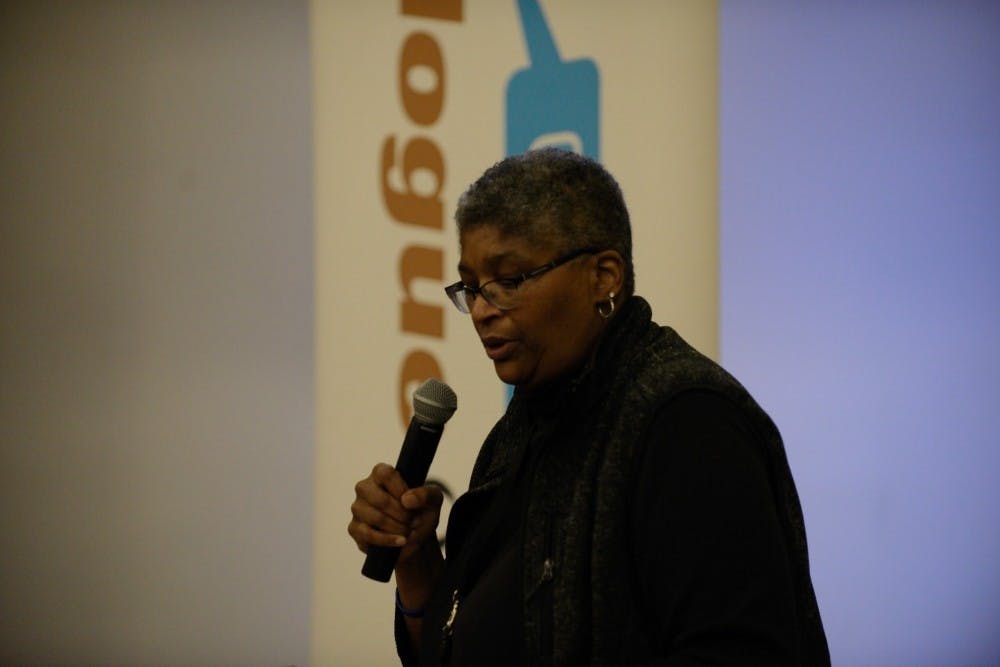Around 50 community members convened at the Jefferson School African American Heritage Center Monday night for a Charlottesville Dialogue on Race strategy meeting. The meeting followed a series of dialogues held throughout the fall and which concluded with a community vote on action ideas Dec. 11.
At the meeting in December, attendees voted on ideas discussed during the fall dialogues to implement into an action plan. The votes from the December meeting were presented to attendees Monday night on a handout given out at the door.
The issues that garnered the most votes were under the Economic Work Group on affordable housing with 54 votes and under the Social/Cultural Work Group on promoting local history events to highlight stories that have been intentionally hidden, with 61 votes.
Votes were cast under four “work groups” on topics such as economics, government, education, social and cultural, and an additional group focused on recovery following the white nationalist events of Aug. 11 and 12. This final group, titled Recovery/Preparation, was not directly voted on at the dialogue meeting in December.
The Dialogue on Race began in 2009 to discuss race relations and tensions in Charlottesville and address them with community engagement and collaboration.
Charlene Green, manager of the Charlottesville Office of Human Rights, spoke at the beginning of the event and gave the attendees directions on the charges of each work group. She explained that, while some ideas received more votes than others, it should not discourage work groups from tackling those other issues.
Green directed each work group to individual rooms for break-out sessions on their respective topics. Each work group would address the ideas voted on in December and work with the agenda and action plan handed to them upon arrival. Each was expected to choose co-chairs and establish a meeting time to continue their work. According to Green, she and the Office of Human Rights will help organize the meetings.
Green also reminded the dialogue participants that diversity should remain a priority within their groups.
“It would be nice if the chairs did not look like each other,” Green said. “There is not a lot of flavor in this room right now.”
She advised each work group to extend their communication and engagement to communities beyond their current representation in an effort to diversify the voices and experiences in each group.
Before breaking out into groups, a woman in the audience asked Green about an “end game” and deadline for their work. Green responded saying the deadline for their work is whatever it takes. She cited the example of the Vinegar Hill Memorial — which was a result of the 2010 Dialogue on Race — and has yet to be built.
Attendees were also given a printed chart of institutional responses from the community to Aug. 12 across Charlottesville, from clergy to government, as well as the University.
“We’re still always going to have those same issues of housing, employment, education, but what is now on people’s minds are — how do we address white supremacy?” Green said. “Not just looking at racism, how do we address white supremacy? How do we deal with a group of people who are not just coming into town on a regular basis but actually live in town and are now more comfortable because of the political environment and the institutional environment?”
Community member and mother, Valerie Washington, said that, while this summer cast a spotlight on racism in Charlottesville, the city is no stranger to its evils.
“Even though you saw the ugliness of racism in Charlottesville this summer, it’s been here, it’s been systematic for years,” Washington said.
Green still has hope, however, in the city’s ability to move in the right direction and make progress.
“Right now I have a lot of hope that we are going to be able to move forward — until I see differently,” Green said in response to a question about the new city council and their involvement in this project.
Although some members of the Charlottesville community were present at Monday’s Dialogue on Race strategy meeting, there was one part of the community missing in the audience — students.
“Where I would really like to see more interest is from the students, especially undergrads,” Green said.
According to Green, the historical separation between the students and the community has persisted over the years. The “town and gown” dichotomy exists today and influences the community, Green said.
“There is nothing more evident than having students downtown or groups of students go to places where there are are a mix of local folks and see the distance, even though they are so close,” Green said.
Other community members present also stated they would like to see more students from the University engaged in these issues.
The Dialogue on Race will continue to meet as individual work groups organized by the Office of Human Rights.







